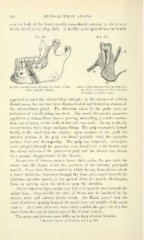Page 486 - My FlipBook
P. 486
484 DENTO-AL VEOLAR A BSCESS.
over the hody of tlio lower maxilla immediately anterior to the groove
for the facial artery (Fig. 4G8). A flexible })robe passed into the fistula
Fig. 46"; Fig. 468.
Fistula passing down tlirough the body of the Abscess with tortuous sinus opcninK up.m
lower maxilla (Black). the face: A, tissue of chock; B, floor
of mouth C, abscess tract.
;
a})j)eared to enter the submaxillary triangle ; in the absence of evident
dental cause, the case had been diagnosticated and treated as abscess of
the submaxillary gland. The direction taken l)y the probe gave no
indication of a tooth being involved. The usual thera])eutic measures
applied to a submaxillary abscess proving unavailing, a serial examina-
tion, one of many, of the teeth of that side was made. In one tooth, the
second molar, was a large amalgam filling. The pulp responded, though
feebly, to the usual tests for vitality ; upon entrance to the tooth the
anterior portion of the pulp was found partially vital, the posterior
portion dead and decomposing. The pulp was removed ; antiseptics
were pumped through the posterior root, found exit at the fistula, and
the causal relation of the putrescent pulp and the abscess was shown
by a prompt disappearance of the disease.
In one case of abscess upon a lower third molar, the pus made en-
trance into the tissues about the insertion of the internal pterygoid
muscle. Cases have been recorded in which the pus from abscess about
a lower molar has burrowed through the bone and, caught beneath the
platysma myoides muscle, it has passed down the muscle, discharging
from an opening upon the neck or upon the shoulder.
Abscess upon an upper molar may find exit upon the face beneath the
malar bone. Occasionally the duct of Steno may be involved in the
abscess tract and salivary fistula result. Dr. Black states' that the
cases of abscess opening beneath the malar bone are usually of the acute
variety. As a rule, however, cases which exhibit the pus exit at a dis-
tance from the seat of abscess are of the chronic variety.
The acute and chronic cases differ as to their clinical histories.
1 American Sydem of Dentistry, vol. i. p. 940.


